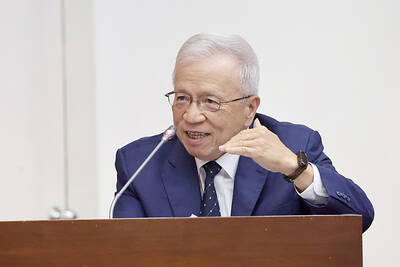E Ink Holdings Inc (元太科技), the world’s largest e-paper display supplier, yesterday said it expects its revenue and net profit to hit historical highs in the next three years through 2028, fueled by rising uptakes of its new large signage, and robust demand for store shelf labels and electronic readers with color displays.
To cope with growing customer demand, E Ink plans to build a new production line, called H6, to expand capacity for large e-paper displays, such as 30-inch displays for indoor and outdoor signage, the company said.
Multiple production lines are planned, as the company’s board of directors approved a new capacity program totaling NT$3.37 billion (US$107.83 million) for acquiring land and leasing a manufacturing facility in Taoyuan’s Guanyin District (觀音), it said.

Photo: Chen Mei-ying, Taipei Times
“We have a chance to see E Ink’s revenue and profit hit record highs in the next two to three years,” E Ink chairman Johnson Lee (李政昊) told investors via an online conference.
The e-paper displays used in signage would outgrow other business segments next year due to a lower base, Lee said.
E Ink is counting on a new e-paper display production line, dubbed H5, to bring extra growth next year, he said.
“We expect our large-e-paper module factory to be fully utilized next year. The module production line operated by our joint venture with AUO Corp (友達) will also be fully loaded,” Lee said.
The e-paper displays for electronic shelf labels (ESLs) would come next, as the major international retailers in the US, the UK and Europe are increasingly replacing paper labels with ESLs, Lee said.
US tariffs and labor shortages have prompted large-scale retailers to quicken their pace to install ESLs, he said.
This year, E Ink expects to ship 25 percent more ESL e-paper displays to 500 million units, compared with about 370 million last year, Lee said.
The growth would extend into next year, he added.
The company also expects growth from e-paper displays used in e-readers and e-notes, driven by replacement demand for those equipped with color displays.
The integration of artificial intelligence features into those devices is also boosting consumers’ interest, the company said.
E Ink’s revenue grew at an annual rate of 29 percent to NT$29.1 billion in the first three quarters from NT$22.49 billion.
Net profit surged 76 percent to NT$9.4 billion in the first three quarters from NT$5.35 billion in the same period last year, setting an all-time high. That surpassed the NT$8.87 billion the company reported for the whole year of last year.
Earnings per share climbed to NT$8.17 from NT$4.67 over the period, company data showed.
Gross margin rose to 56.44 percent from 47.84 percent a year earlier, according to the data.

JITTERS: Nexperia has a 20 percent market share for chips powering simpler features such as window controls, and changing supply chains could take years European carmakers are looking into ways to scratch components made with parts from China, spooked by deepening geopolitical spats playing out through chipmaker Nexperia BV and Beijing’s export controls on rare earths. To protect operations from trade ructions, several automakers are pushing major suppliers to find permanent alternatives to Chinese semiconductors, people familiar with the matter said. The industry is considering broader changes to its supply chain to adapt to shifting geopolitics, Europe’s main suppliers lobby CLEPA head Matthias Zink said. “We had some indications already — questions like: ‘How can you supply me without this dependency on China?’” Zink, who also

At least US$50 million for the freedom of an Emirati sheikh: That is the king’s ransom paid two weeks ago to militants linked to al-Qaeda who are pushing to topple the Malian government and impose Islamic law. Alongside a crippling fuel blockade, the Group for the Support of Islam and Muslims (JNIM) has made kidnapping wealthy foreigners for a ransom a pillar of its strategy of “economic jihad.” Its goal: Oust the junta, which has struggled to contain Mali’s decade-long insurgency since taking power following back-to-back coups in 2020 and 2021, by scaring away investors and paralyzing the west African country’s economy.

BUST FEARS: While a KMT legislator asked if an AI bubble could affect Taiwan, the DGBAS minister said the sector appears on track to continue growing The local property market has cooled down moderately following a series of credit control measures designed to contain speculation, the central bank said yesterday, while remaining tight-lipped about potential rule relaxations. Lawmakers in a meeting of the legislature’s Finance Committee voiced concerns to central bank officials that the credit control measures have adversely affected the government’s tax income and small and medium-sized property developers, with limited positive effects. Housing prices have been climbing since 2016, even when the central bank imposed its first set of control measures in 2020, Chinese Nationalist Party (KMT) Legislator Lo Ting-wei (羅廷瑋) said. “Since the second half of

Taiwan Semiconductor Manufacturing Co (TSMC, 台積電) received about NT$147 billion (US$4.71 billion) in subsidies from the US, Japanese, German and Chinese governments over the past two years for its global expansion. Financial data compiled by the world’s largest contract chipmaker showed the company secured NT$4.77 billion in subsidies from the governments in the third quarter, bringing the total for the first three quarters of the year to about NT$71.9 billion. Along with the NT$75.16 billion in financial aid TSMC received last year, the chipmaker obtained NT$147 billion in subsidies in almost two years, the data showed. The subsidies received by its subsidiaries —